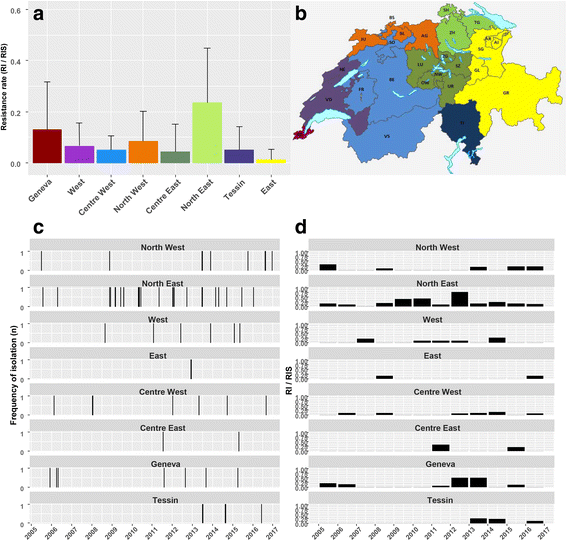Prevalence of carbapenem-resistant Acinetobacter baumannii from 2005 to 2016 in Switzerland
- PMID: 29614963
- PMCID: PMC5883518
- DOI: 10.1186/s12879-018-3061-5
Prevalence of carbapenem-resistant Acinetobacter baumannii from 2005 to 2016 in Switzerland
Abstract
Background: We describe the prevalence of invasive carbapenem-resistant Acinetobacter spp. isolated from 2005 to 2016 in different regions of Switzerland.
Methods: Using the Swiss Antibiotic Resistance Centre (anresis) database that includes data from 70% of all hospitalized patients and one third of all ambulatory practitioners in Switzerland, we analysed the number of carbapenem-susceptible and resistant Acinetobacter spp. isolated from blood or cerebrospinal fluid, and further described their temporal and regional fluctuations.
Results: From 2005 to 2016, 58 cases of resistant or intermediate strains to carbapenem were observed among 632 cases of invasive Acinetobacter. Multivariable analyses indicated that the number of carbapenem-resistant isolates (mean 4.8 ± sd 2.12) and carbapenem resistance rates per region per annum (8.4% ± 13.9%) were low and stable over the studied period. Large fluctuations were observed at the regional level, with e.g. the North East region displaying resistance rates twice as high as that found in other regions.
Conclusion: Despite a relatively stable number of carbapenem-resistant Acinetobacter isolates in Switzerland, our results suggest the existence of a diverse pool of A. baumannii species in hospital settings, and confirm the implication of carbapenem-resistant Acinetobacter calcoaceticus-Acinetobacter baumannii (ACB) complex in the vast majority of clinical infections and nosocomial outbreaks with notable regional fluctuations.
Keywords: Acinetobacter baumannii complex; Carbapenem resistance; Epidemiology; Regional trends; Surveillance; Temporal trends.
Conflict of interest statement
Ethics approval and consent to participate
Analysis and publication of the data presented in the study were done in agreement with the steering committee of the Swiss Centre for Antibiotic Resistance (ANRESIS).
Competing interests
The authors declare that they have no competing interests.
Publisher’s Note
Springer Nature remains neutral with regard to jurisdictional claims in published maps and institutional affiliations.
Figures

References
-
- Nemec A, Krizova L, Maixnerova M, van der Reijden TJ, Deschaght P, Passet V, et al. Genotypic and phenotypic characterization of the Acinetobacter calcoaceticus-Acinetobacter baumannii complex with the proposal of Acinetobacter pittii sp. nov. (formerly Acinetobacter genomic species 3) and Acinetobacter nosocomialis sp. nov. (formerly Acinetobacter genomic species 13TU) Res Microbiol. 2011;162(4):393–404. doi: 10.1016/j.resmic.2011.02.006. - DOI - PubMed
Publication types
MeSH terms
Substances
LinkOut - more resources
Full Text Sources
Other Literature Sources
Medical
Miscellaneous

